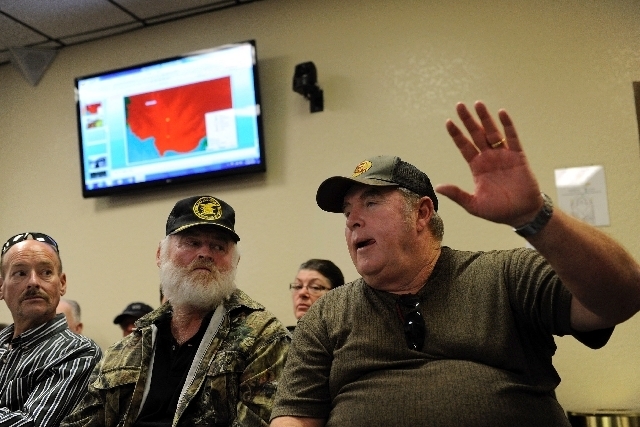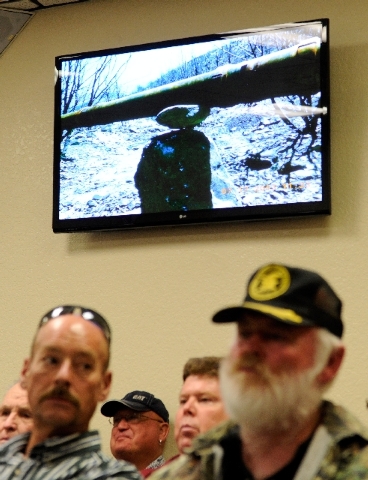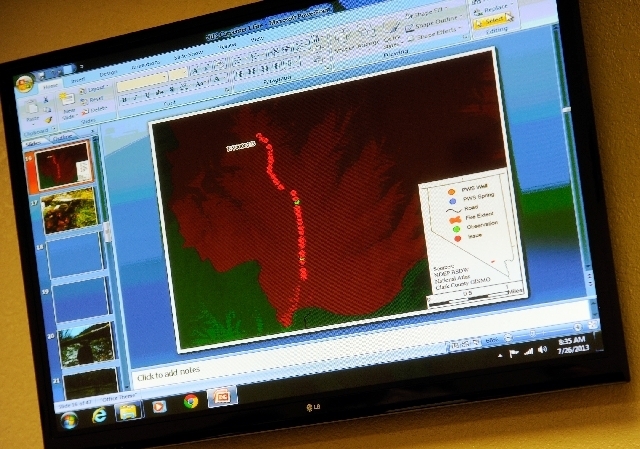Trout Canyon residents thirsty for help with pipeline problem
Residents of Trout Canyon are concerned, frustrated, and most of all, parched.
More than three weeks after lightning started a massive wildfire that edged up to their homes and wrecked their aging water system, the homeowners are still living without running water.
“We’re in crisis mode,” Trout Canyon resident Dennis Walker said. “We’re at day 23 now without water. We need water.”
Officials from Clark County, the Southern Nevada Health District and the U.S. Forest Service met with residents at the health district office in Las Vegas Friday to discuss options.
Health district officials said the fire essentially destroyed the roughly three miles of privately owned pipeline that carries spring water from a cave in the mountains to the 20 plus homes in Trout Canyon.
“There were 82 plus areas that would have to undergo some fixing,” said Nate Diaz, an environmental health specialist with the health district. “There were a lot of issues.”
The metal pipe, which is more than 50 years old and mostly made from World War II-era munitions canisters, is supported by boulders and laid in washes, leaving it vulnerable to post-fire flooding, according to Dennis Campbell, health district environmental health manager.
He said current laws governing water systems would not allow an above-ground pipeline like the one that used to serve Trout Canyon. If the system has to be rebuilt, it will have to be done to today’s standards.
“Whatever solution we work out, we have to get it approved through the state,” Campbell said. “From our perspective, the entire distribution line has been compromised.”
Residents discussed several ideas, including making temporary repairs to the line while a long-term plan is worked out.
But Campbell warned that trying to patch up the pipe may not be best way to go. “It’s kind of like a money pit. You fix one place, another three could break,” he said.
Even so, some homeowners seemed relieved that such a quick fix is even an option. “We were worried whether we would be allowed back there” onto Forest Service land, said 35-year Trout Canyon resident Greg Jameson. “It looks like they will let us do whatever we need to do for a temporary fix,” provided the proper protocol is followed.
Money may turn out to be the biggest barrier to restoring running water to Trout Canyon.
An estimate given to residents 10 years ago pegged the cost of constructing a new water line at $3 million. That number likely would be much higher now, officials said.
Shawn Hastings from U.S. Department of Agriculture Rural Development emphasized the importance of the community registering as a non-profit organization before applying for funds, and employing an engineer to get an estimate on damages and costs.
“We base funding off of a preliminary engineering report,” he said.
Funding is not the only obstacle residents face in the coming weeks and months. Before any repairs can be made, there has to be a plan in place that passes muster with federal, state and local regulators.
“We are very willing to facilitate whatever is possible to get water,” said Shawnee Hinman, a special uses permit administrator for the Forest Service. “We’re not looking to hold this water line back.”
Officials will consider such things as the alignment of the water line, whether it will be buried or above ground, the types of material used, the types of equipment needed to build it and where road access would be.
Dan Tarnowski with the Nevada Rural Water Association didn’t sugarcoat the situation. “You’ve seen the condition of your water system. We need to get together. Time’s a wastin’.”
The good news, Tarnowski said: “There’s a lot of people interested in helping you. You just have to open the door and let them in.”
While people scramble to plan and find solutions, they are not completely without water.
The Clark County Office of Emergency Management and Homeland Security is providing some potable and non-potable water, as well as portable restrooms and showers.
“We brought another tanker up there yesterday ,” Clark County Deputy Fire Chief Fernandez Leary said.
The tanker holds 3,100 gallons of potable water, and it replaced a tanker filled with 2,000 gallons of potable water and a 4,000-gallon tanker of non-potable water that have been parked on the mountain and periodically refilled since residents were allowed home July 14.
It’s unclear how much longer that help will last. Leary said the county might only be able to keep the water tankers in place for a few more weeks at most.
There was some talk Friday of trying to bring in a much larger tanker truck or some temporary storage tanks after the county vehicles head home, but such options could be limited by the condition of the dirt roads leading to and through the community.
Ultimately, the future of Trout Canyon will rest in the hands of its residents. Officials promised to help as much as they can, but it will be up to residents to work together, brainstorm ideas and find a way to pay for them.
“It could be months,” Walker said. “We’re still in crisis mode until we have water.”
Contact Rochel Leah Goldblatt at rgoldblatt@reviewjournal.com or 702-383-0381. Contact Henry Brean at hbrean@reviewjournal.com or 702-383-0350.
























